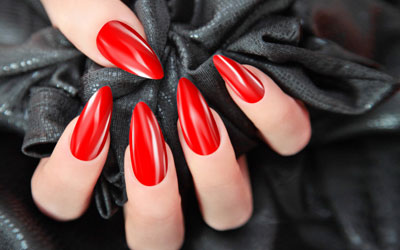 Acrylic is the one nail enhancement that undoubtedly everyone has heard of. It is still very much top of salon list when it comes to offering a nail service. Acrylic was founded many years ago and originated from use in dentistry procedures. Following its discovery it was then improved chemically to a formulation that was on more of a ‘nail-friendly’ scale.
Acrylic is the one nail enhancement that undoubtedly everyone has heard of. It is still very much top of salon list when it comes to offering a nail service. Acrylic was founded many years ago and originated from use in dentistry procedures. Following its discovery it was then improved chemically to a formulation that was on more of a ‘nail-friendly’ scale.
There had been much controversy that acrylic nails damage natural nails. Dentistry acrylics contained a chemical called MMA (methalmethacrylate) which over the years in the nail industry evolving and it being used to create acrylic enhancements, figures began to rise in consumer complaints in which the FBA prohibited in the late 70’s.
When I refer to MMA and EMA liquid, I refer to the liquid that is used with a powder to create acrylic nails. EMA (ethalmethacrylate) then replaced MMA Liquid. This is a chemical based product that most reputable nail technicians will practice today in salons to deliver a kind, and safe service to clients. However there are still salons/technicians that will use a MMA based liquid to carry out your treatment. MMA is so so strong that women who have already worn this product think they’re the best set of nails they’ve ever had because they’re been invincibly unbreakable. Thinking logically about this, when having our false teeth made we wouldn’t be wanting them to break as we bite into our food, now imagine breaking a nail; its not the enhancement that shatters but instead our natural nail. Hence the inflation of complaints made back in the 70’s. EMA liquids have larger molecules which give nail enhancements strength, durability longer lasting and most importantly flexibility. When the enhancement breaks, the enhancement breaks. Not your nail. Unless or course you slam it in a door or any other untoward accident.
The point is we believe that artificial nails should not only be beautiful, they should not damage the natural nail. They are enhancements. Not replacements. It is the responsibility of all professional nail technicians to protect the health of they’re clients natural nails and a good place of start is by using responsibly formulated products, to learn safe and proper techniques and to be compliant with health and safety and sanitisation regulations.
Never feel afraid to ask your technician if they are EMA friendly.
Signs to look out for (for MMA use) are – cloudy or milky coloured when cured, enhancements will not soak off in solvents designed to remove acrylics, enhancements are extremely hard and very difficult to file even with coarse abrasives, MMA has an unusual strong or strange odour which does not smell like other acrylic liquids (although liquids do have a strong odour I’m sure most of us recognise that smell when entering a salon) low cost full sets or fills, dust or ventilation masks worn by technicians and unlabeled containers.
Acrylic’s in my salon are definitely EMA friendly.
Acrylic’s are made up of a powder (polymer) and a liquid (monomer) that when mixed together a polymerisation occurs and cures into a plastic acrylic – your nails. It is a work of art that involves sculpting with or without a tip and is then filed and buffed into a perfect nail enhancement.
Acrylic is the most amazing and versatile product I have worked with. Creativity is my forte and the joy I experience from performing acrylic nails satisfies me immensely.Acrylic is the one nail enhancement that undoubtedly everyone has heard of.
It is still very much top of salon list when it comes to offering a nail service. Acrylic was founded many years ago and originated from use in dentistry procedures. Following its discovery it was then improved chemically to a formulation that was on more of a ‘nail-friendly’ scale.
Acrylic divinities’s range from performing –
- Sculpted Nails – a sticky paper form is placed around the finger, beneath the free edge of the nail and acrylic is sculpted upon it building new nails. Great also for nail biters, damaged nail beds, and damaged toe nails.
- Coloured Acrylics – Allows you to create fun funky looking nails. From elegant pink and white’s, colour fades and coloured glitters.
- Perfect to use with white tips creating a permanent French look.
- Sculpting of 3D work Creating all sorts that you never thought imaginable – 3D roses, pansies, poppy’s, leaves, orchids, holly leaves, snowmen and what ever my little brushes come up with next.
My recently ‘passed’ training has been learning how to create my 3D work, so I’m sure you will be as excited by seeing my results as I have been. Requests are coming in thick and fast.
Acrylic, like other systems will require an infill appointment 2-3 weeks after your first set has been applied. This involves buffing down the acrylic and rebalancing with a new acrylic layer filling the gap that becomes apparent at the base of your nail around the cuticle area. And always Oil Oil Oil.
Acrylic is easily removed by being dissolved in acetone which would normally take around 30-40 minutes. This should always be done by a professional nail technician. Those that try it at home themselves will never complete the job as a professional trained nail technician would. We are as professionals, serious about removing nails as we are putting them on for you.